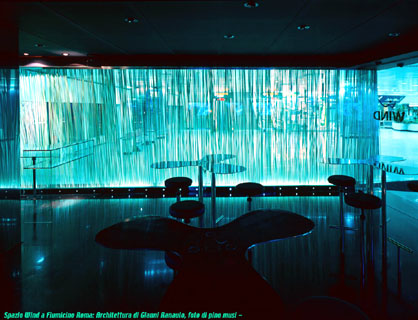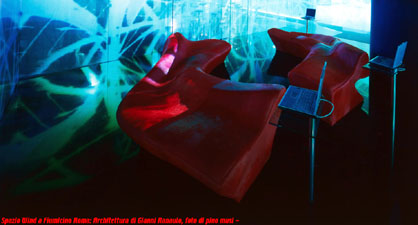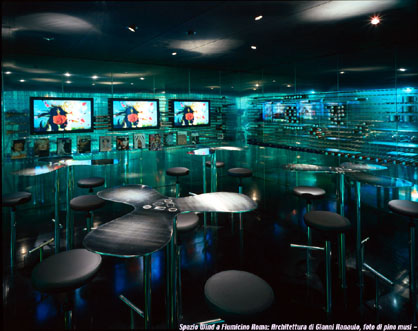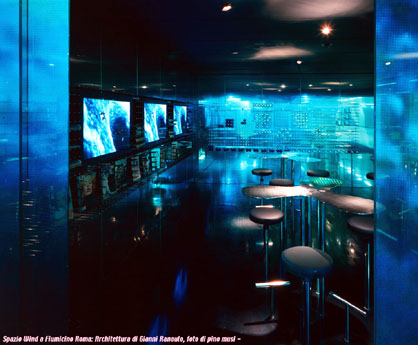|
|
| home |
| Leggere Antonino Saggio |
||||
 Gianni Ranaulo Light Architecture: New Interventions on the Urban Scene (The IT Revolution in Architecture) Switzerland 2001 Birkhäuser pp96, $12.50 preface by Antonino Saggio buy the book online and save! |
||||
| [in italiano] > IT REVOLUTION BOOK SERIES |
I thought a bit about the paragraph used as the
introduction to this book. The quotes from Lezioni Americane are overused. In finding such an obvious quote, the scholar would make a
face, the expert critic would smirk, the experienced reader shrug his shoulders. But many who will read Light Architecture will find that
this quote, that recalls Perseus who held himself up by the winds, is very appropriate. Gianni Ranaulo absolutely could not have done
better since this book makes the verb become adjective*. The architecture presented here by the author aspires to being light; the figures that accompany the text are light and like the reflections from a mirror. The pages turn as if blown by a breath and our light image. But do not be deceived, simplicity and lightness are difficult to obtain. Whether of the gymnast who spins in the air or a writer such as Italo Calvino, simplicity hides an essential and important substance.  I was led to working in architecture with the conviction that no limits must be placed on the design. As a consequence of this, there must be no misunderstanding between the materials and meanings, between the means and the ends. For a long time now, there has been an attempt to confine architecture to those hard materials of permanent structures: steel, reinforced concrete, stone and granite. As a consequence of this artificial confinement, terms have been invented that are reductive or simply ugly. When working with green spaces, trees, meadows, flowers or movements of earth or temporary structures, there was the "art of gardening"; when stone was substituted by papier-mâché, there was "set design"; when the materials were mobile, there was "furnishing"; when the objects were used in public spaces, there was "urban furnishing". |
[20apr2002] | ||
But if we turn the question around, everything
becomes clear. Design in relation to space is architecture but it is an architecture, depending on the case, needs and limitations, that
uses different materials. From hard and permanent to light materials made of water, vegetation, reflections and light. This type of
reasoning opens up a whole range of activities to the designer that, depending on the case and need, multiplies the possibilities of the
project. "Depending on the case and need" means, for example, that when the architect cannot build a wall of stone, he can build one with a spray of water; when he wants to redirect flows and lines, he can do it with a painting or projection (if we do not wish to use ancient obelisks); when he needs a new spatiality, he could perhaps use fabrics, curtains, or if he really needs them he can dig his spaces out of the earth or hang them in mid-air like a balloon. Naturally, I knew that, in this expanded idea of design with a palette of light materials, the computer was a necessary tool in a thousand ways. But I could show very little in this direction beyond that great and brilliant forerunner Toyo Ito and something from the prophetic Jean Nouvel. The first merit of this book is in greatly expanding the number of examples and their operational and theoretical substrata, the second is in contributing to making concrete a new idea of the contemporary city.  Electronics and information technology systems can in fact furnish tools for the development of those "anti-zoning" areas around which modern life tends more and more to be arranged. Aside from being multi-functional zones (with activities that are productive, recreational, social and, in some cases, even residential) and helping in the needed return to nature in outlying areas frequently built with brutality and an insane density, they must, in order to actually function, have a nervous system made of technology, or rather information technology. This means systems of interactive control, of illumination, of "information" in the real sense. Only then will we have city sectors open to that multifunctionality and plurality of use that is the promise of the information technology civilization. The problem as always is "how". For years Ranaulo has studied and applied precisely this idea to numerous designs. While going through the text you will also find many designs by artists, landscape artists and architects who move through this new territory heavily traveled by the light of information.  Miracles of Information Technology. Paul Virilio, and this quote is compulsory since this book gives concrete form to many of the French thinker's theories, spoke of the Electronic Gothic. Architecture is becoming a support for information, not to mention an advertising
support and, in a broader sense, a mass media support […] The Electronic Gothic of media buildings illuminates the crossroads –Times
Square for example– in the same way that, in the Gothic cathedral, stained glass windows illuminated the nave or the presbytery to tell
the story of the Church... time is no longer the time of a sequence alternating between day and night, but a time of immediacy, of
instantaneousness and ubiquity; in other words, it possesses what in the past were the attributes of divinity. Today, architecture and information technology go beyond the Electronic Gothic of the
illuminating macro-object (the cathedral, much like a symbolic tower, in Bilbao of which I have spoken on other occasions) to once again
directly face the issue of the urban setting. This happens not only because we have new tools for conceiving space (palimpsests, layers,
dynamic diagrams, in-between spaces, emerging forms, etc.) but because the real and the virtual can now be combined in a manner once
unheard of. As this book shows, this refers to the development of projection systems almost inside the shell itself of the building that
give the effect of a sort of new, mass-media illusionism. So we can look forward to an Information Era Baroque, with its new Piazza
Navonas, new Trevi Fountains and new Trinità dei Monti of 2006; in other words, a new, interactive urban choreography. |
||||
| * The title, "Leggere", has been left
in Italian since I feel that the double meaning attributed to this term as it is used here in Italian cannot be duplicated in English. (Trans.
Note: With the accent on different syllables in Italian, it can either mean the verb "to read" or the adjective
"light"). All pictures on this page are by Pino Musi and are referred to the Spazio Wind designed by Gianni Ranaulo just opened in the Fiumicino Airport, Rome. |
||||
|
coffee
break | forum | scrivi all'autore |
||||
|
Per qualsiasi comunicazione laboratorio
|